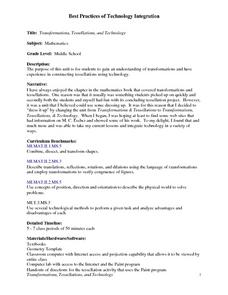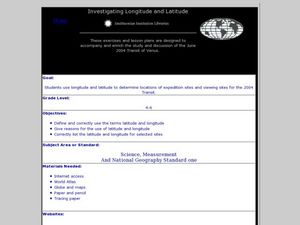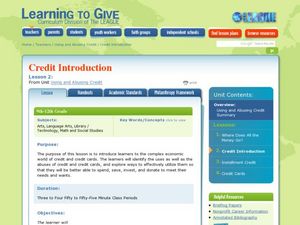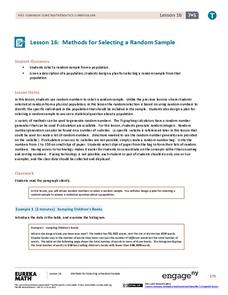Curated OER
Transformations, Tessellations, and Technology
Middle schoolers complete a unit about transformations and tessellations. They explore various tessellation websites, determine which shapes tessellate, complete a log about which website activities they complete, and create a...
Alabama Learning Exchange
How Old Is That Tree?
Fifth graders study environmental changes by examining the annual rings of a cross-section of a tree trunk. They access websites to complete a worksheet on the parts of a tree. They count the annual rings on a tree slice while observing...
Curated OER
Weather Dot Com
Students examine the need for a standard unit of temperature and measure temperature with a thermometer. They discuss the details of a thermometer and the calibrations used, record temperature data for inside and outside, explore...
Curated OER
Bow Wow, Oink Oink
Students read Everybody Cooks Rice and discuss birthday celebrations around the world. In this cultural differences instructional activity, students discuss the Chinese symbols by birth years. Students create a graph by...
Curated OER
Exploring Online Data Analysis Tools Project Interactivate- Plop It
In this data analysis instructional activity, students access an online data analysis tool at the given web site. They collect name length data for classmates and enter it into the tool. The find and manipulate the data to determine how...
Curated OER
Bits and Pieces - More About Percents - Online Manipulatives
In this online percentages worksheet, students access the Library of Virtual Manipulatives web site and open the percentage tool. They use the online tool to complete 8 multi-step questions making graphical representations and finding...
Curated OER
Investigating Latitude and Longitude
Students examine the lines of latitude and longitude on a map, and explain why these lines might be useful. In this lesson students also explore websites that provide information to improve their understanding of how and why latitude and...
Curated OER
The Ancient Maya
Students explore the culture of the Mayans through a variety of activities. In this lesson about Maya, students analyze pictures in books and on websites, produce scale models of Maya architecture, and create Maya mosaics. Students study...
Curated OER
Fraction Conversion 2 (With Percents)
Fifth graders determine how to convert fractions, decimals, and percents. In this conversion lesson, 5th graders use an on-line applet to practice making these conversions. They review how to make the conversions in a whole class lesson...
Curated OER
Credit Interview
Student determine a safe debt load. In this credit interview lesson, students explore the importance of budgeting, saving and investing. They examine the pros and cons of using a credit card. Students discuss how to build credit, apply...
Curated OER
Biomimicry, Nature: Architecture of the Future
Students explore the relationship between nature and architecture. In this cross curriculum history, culture, and architecture instructional activity, students observe and discuss structures visible in nature. Students view websites in...
Curated OER
Smart- Counting Coins
Students discover the name and value of coins. In this counting money lesson, students identify heads and tails of coins and the value of each coin. Students visit websites and play games. Students then write a poem about money.
Curated OER
Heart Smart in a Heart Beat
As an introductory activity, young statisticians measure their heart rate at rest and after exercise and compute the mean and median, and create a box & whisker plot. This is followed by watching a video (that no longer seems...
Curated OER
Writing Numbers in Words
For this writing numbers in words worksheet, students write a set of 10 single and 2-digit numbers in word form. A reference web site is given for additional activities.
Curated OER
Classify Quadrilaterals
Here is a quadrilateral worksheet in which learners choose words that describe shapes, words to complete sentences that describe shapes. A reference web site is given for additional activities.
Curated OER
Complementary and Supplementary Angles #3
Learners are given one angle measurement and determine either the corresponding supplementary or complementary angle measurement. A reference web site is given for additional activities.
Curated OER
Angles: Greater Than, Less Than or Equal To 90 Degrees?
In this angles worksheet, students check the correct box, identifying angles as either greater than, less than or equal to 90 degrees. A reference web site is given for additional activities.
Curated OER
Protractor #4
For this angles worksheet, students measure and label angles as either acute, right, obtuse or straight. A reference web site is given for additional activities.
Curated OER
Protractor #5
In this measuring angles worksheet, students measure a set of angles, then check the appropriate measure and name of each. A reference web site is given for additional activities.
Curated OER
What Does Not Belong?
In this same or different worksheet, students circle all items that don't belong in a picture of things packed for a camping trip. A reference web site is given for additional activities.
Curated OER
What Does Not Belong?
In this what belongs worksheet, students circle things that don't belong in a picture of a greenhouse and a yard. A reference web site is given for additional activities.
Curated OER
Handwriting Practice-Numbers 0-10
In this handwriting practice worksheet, students practice tracing the "dotted" numbers 0-10. A reference web site is given for additional activities.
Curated OER
Manatee Endangered
High schoolers (or middle schoolers) research the endangered manatee and the Endangered Species Act. They choose a local animal that is threatened or endangered and attempt to find out what is being done to protect it. Short, but sweet,...
EngageNY
Methods for Selecting a Random Sample
Random sampling is as easy as choosing numbers. Teams use random numbers to create a sample of book lengths from a population of 150 books. The groups continue by developing a technique to create samples to compare from two populations...























